The Cambridge History of Japan, Vol. 3: Medieval Japan
Подождите немного. Документ загружается.

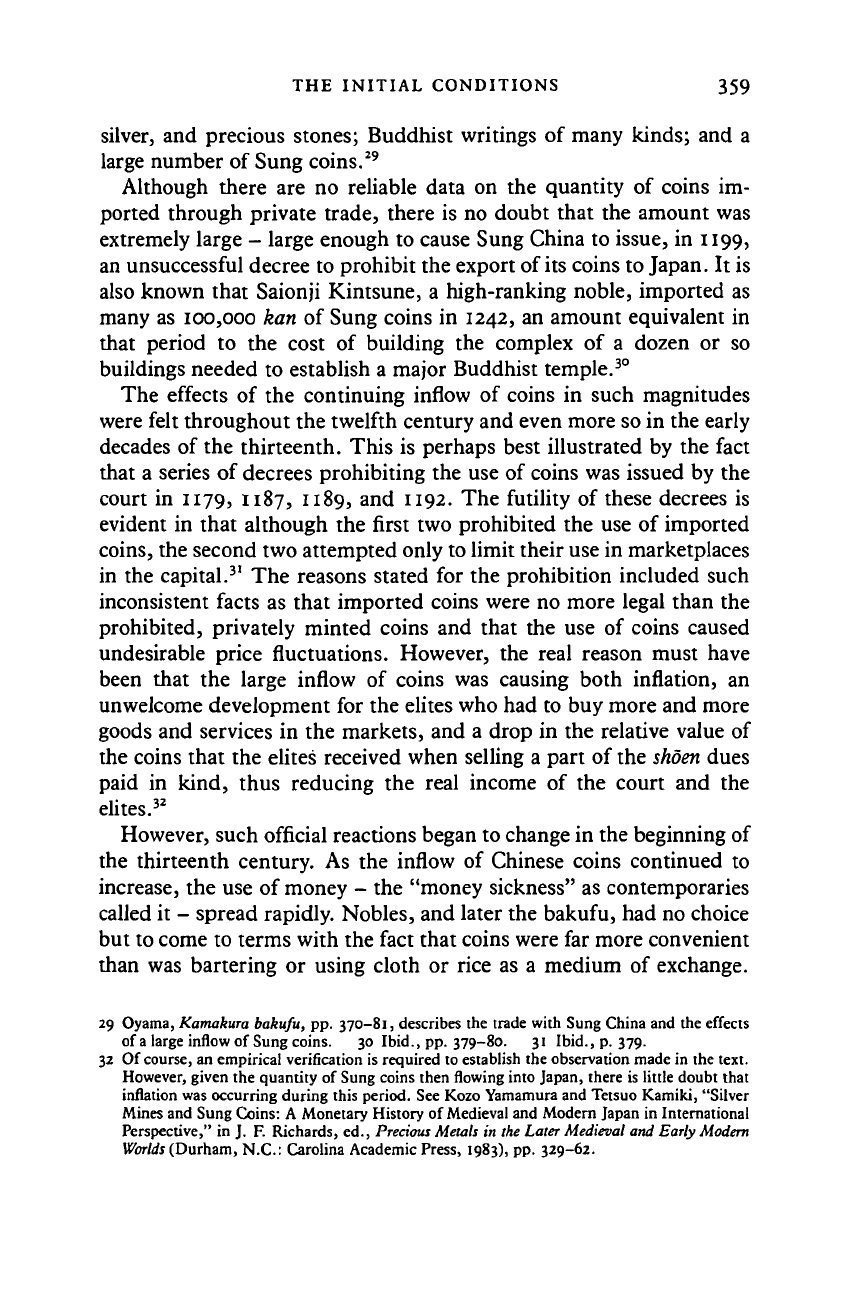
THE INITIAL CONDITIONS 359
silver, and precious stones; Buddhist writings of many kinds; and a
large number of Sung coins.
29
Although there are no reliable data on the quantity of coins im-
ported through private trade, there is no doubt that the amount was
extremely large - large enough to cause Sung China to issue, in 1199,
an unsuccessful decree to prohibit the export of its coins to Japan. It is
also known that Saionji Kintsune, a high-ranking noble, imported as
many as 100,000 kan of Sung coins in 1242, an amount equivalent in
that period to the cost of building the complex of a dozen or so
buildings needed to establish a major Buddhist temple.
30
The effects of the continuing inflow of coins in such magnitudes
were felt throughout the twelfth century and even more so in the early
decades of the thirteenth. This is perhaps best illustrated by the fact
that a series of decrees prohibiting the use of coins was issued by the
court in 1179, 1187, 1189, and 1192. The futility of these decrees is
evident in that although the first two prohibited the use of imported
coins,
the second two attempted only to limit their use in marketplaces
in the capital.
31
The reasons stated for the prohibition included such
inconsistent facts as that imported coins were no more legal than the
prohibited, privately minted coins and that the use of coins caused
undesirable price fluctuations. However, the real reason must have
been that the large inflow of coins was causing both inflation, an
unwelcome development for the elites who had to buy more and more
goods and services in the markets, and a drop in the relative value of
the coins that the elites received when selling a part of the shorn dues
paid in kind, thus reducing the real income of the court and the
elites.
32
However, such official reactions began to change in the beginning of
the thirteenth century. As the inflow of Chinese coins continued to
increase, the use of money - the "money sickness" as contemporaries
called it - spread rapidly. Nobles, and later the bakufu, had no choice
but to come to terms with the fact that coins were far more convenient
than was bartering or using cloth or rice as a medium of exchange.
29 Oyama, Kamakura bakufu, pp.
370-81,
describes the trade with Sung China and the effects
of a large inflow of Sung coins. 30 Ibid., pp. 379-80. 31 Ibid., p. 379.
32 Of course, an empirical verification is required to establish the observation made in the text.
However, given the quantity of Sung coins then flowing into Japan, there is little doubt that
inflation was occurring during this period. See Kozo Yamamura and Tetsuo Kamiki, "Silver
Mines and Sung Coins: A Monetary History of Medieval and Modern Japan in International
Perspective," in J. F. Richards, ed., Precious Metals in the Later Medieval and Early Modem
Worlds
(Durham, N.C.: Carolina Academic Press, 1983), pp. 329-62.
Cambridge Histories Online © Cambridge University Press, 2008
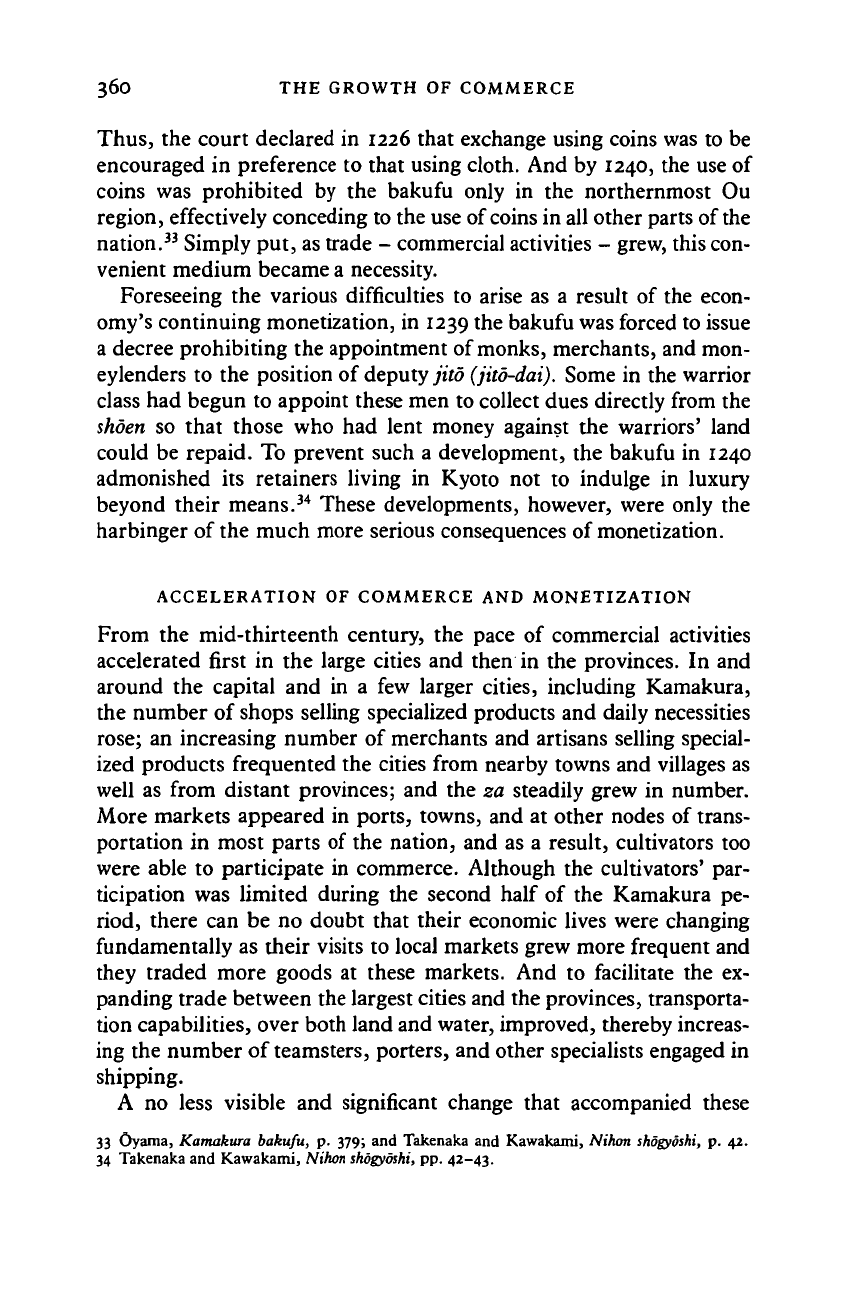
360 THE GROWTH OF COMMERCE
Thus,
the court declared in 1226 that exchange using coins was to be
encouraged in preference to that using cloth. And by 1240, the use of
coins was prohibited by the bakufu only in the northernmost Ou
region, effectively conceding to the use of coins in all other parts of the
nation.
33
Simply put, as trade - commercial activities - grew, this con-
venient medium became a necessity.
Foreseeing the various difficulties to arise as a result of the econ-
omy's continuing monetization, in 1239 the bakufu was forced to issue
a decree prohibiting the appointment of monks, merchants, and mon-
eylenders to the position of deputy
jito
(jito-dai).
Some in the warrior
class had begun to appoint these men to collect dues directly from the
shoen
so that those who had lent money against the warriors' land
could be repaid. To prevent such a development, the bakufu in 1240
admonished its retainers living in Kyoto not to indulge in luxury
beyond their means.
34
These developments, however, were only the
harbinger of the much more serious consequences of monetization.
ACCELERATION OF COMMERCE AND MONETIZATION
From the mid-thirteenth century, the pace of commercial activities
accelerated first in the large cities and then in the provinces. In and
around the capital and in a few larger cities, including Kamakura,
the number of shops selling specialized products and daily necessities
rose;
an increasing number of merchants and artisans selling special-
ized products frequented the cities from nearby towns and villages as
well as from distant provinces; and the za steadily grew in number.
More markets appeared in ports, towns, and at other nodes of trans-
portation in most parts of the nation, and as a result, cultivators too
were able to participate in commerce. Although the cultivators' par-
ticipation was limited during the second half of the Kamakura pe-
riod, there can be no doubt that their economic lives were changing
fundamentally as their visits to local markets grew more frequent and
they traded more goods at these markets. And to facilitate the ex-
panding trade between the largest cities and the provinces, transporta-
tion capabilities, over both land and water, improved, thereby increas-
ing the number of teamsters, porters, and other specialists engaged in
shipping.
A no less visible and significant change that accompanied these
33 Oyama, Kamakura bakufu, p. 379; and Takenaka and Kawakami, Nikon
shogyoshi,
p. 42.
34 Takenaka and Kawakami, Nikon
shogyoshi,
pp.
42-43.
Cambridge Histories Online © Cambridge University Press, 2008
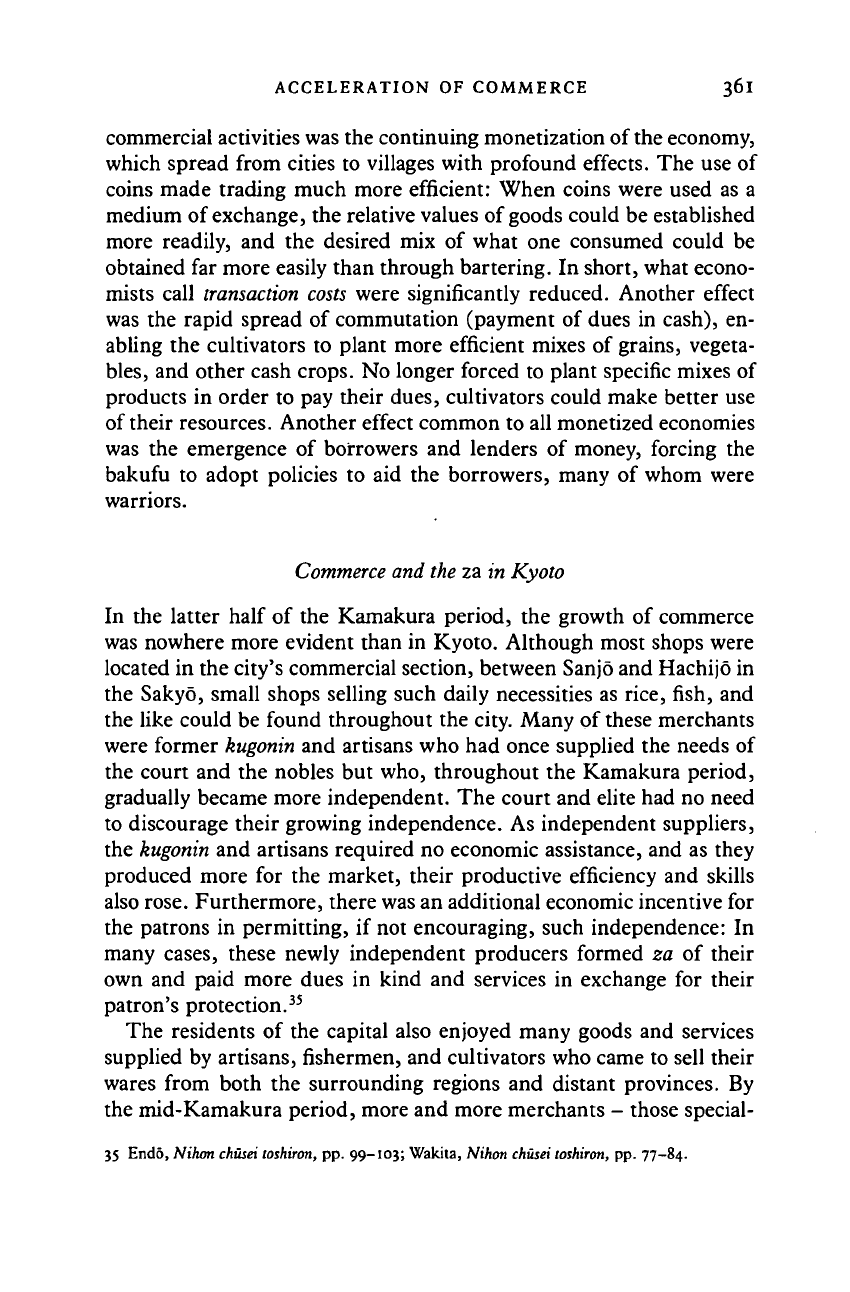
ACCELERATION OF COMMERCE 361
commercial activities was the continuing monetization of the economy,
which spread from cities to villages with profound effects. The use of
coins made trading much more efficient: When coins were used as a
medium of exchange, the relative values of goods could be established
more readily, and the desired mix of what one consumed could be
obtained far more easily than through bartering. In short, what econo-
mists call transaction costs were significantly reduced. Another effect
was the rapid spread of commutation (payment of dues in cash), en-
abling the cultivators to plant more efficient mixes of grains, vegeta-
bles,
and other cash crops. No longer forced to plant specific mixes of
products in order to pay their dues, cultivators could make better use
of their resources. Another effect common to all monetized economies
was the emergence of borrowers and lenders of money, forcing the
bakufu to adopt policies to aid the borrowers, many of whom were
warriors.
Commerce
and the za in Kyoto
In the latter half of the Kamakura period, the growth of commerce
was nowhere more evident than in Kyoto. Although most shops were
located in the city's commercial section, between Sanjo and Hachijo in
the Sakyo, small shops selling such daily necessities as rice, fish, and
the like could be found throughout the city. Many of these merchants
were former kugonin and artisans who had once supplied the needs of
the court and the nobles but who, throughout the Kamakura period,
gradually became more independent. The court and elite had no need
to discourage their growing independence. As independent suppliers,
the kugonin and artisans required no economic assistance, and as they
produced more for the market, their productive efficiency and skills
also rose. Furthermore, there was an additional economic incentive for
the patrons in permitting, if not encouraging, such independence: In
many cases, these newly independent producers formed za of their
own and paid more dues in kind and services in exchange for their
patron's protection.
35
The residents of the capital also enjoyed many goods and services
supplied by artisans, fishermen, and cultivators who came to sell their
wares from both the surrounding regions and distant provinces. By
the mid-Kamakura period, more and more merchants - those special-
35 Endo, Nihon
chusei
toshiron,
pp. 99-103; Wakita, Nihon
chusei
toshiron,
pp. 77-84.
Cambridge Histories Online © Cambridge University Press, 2008
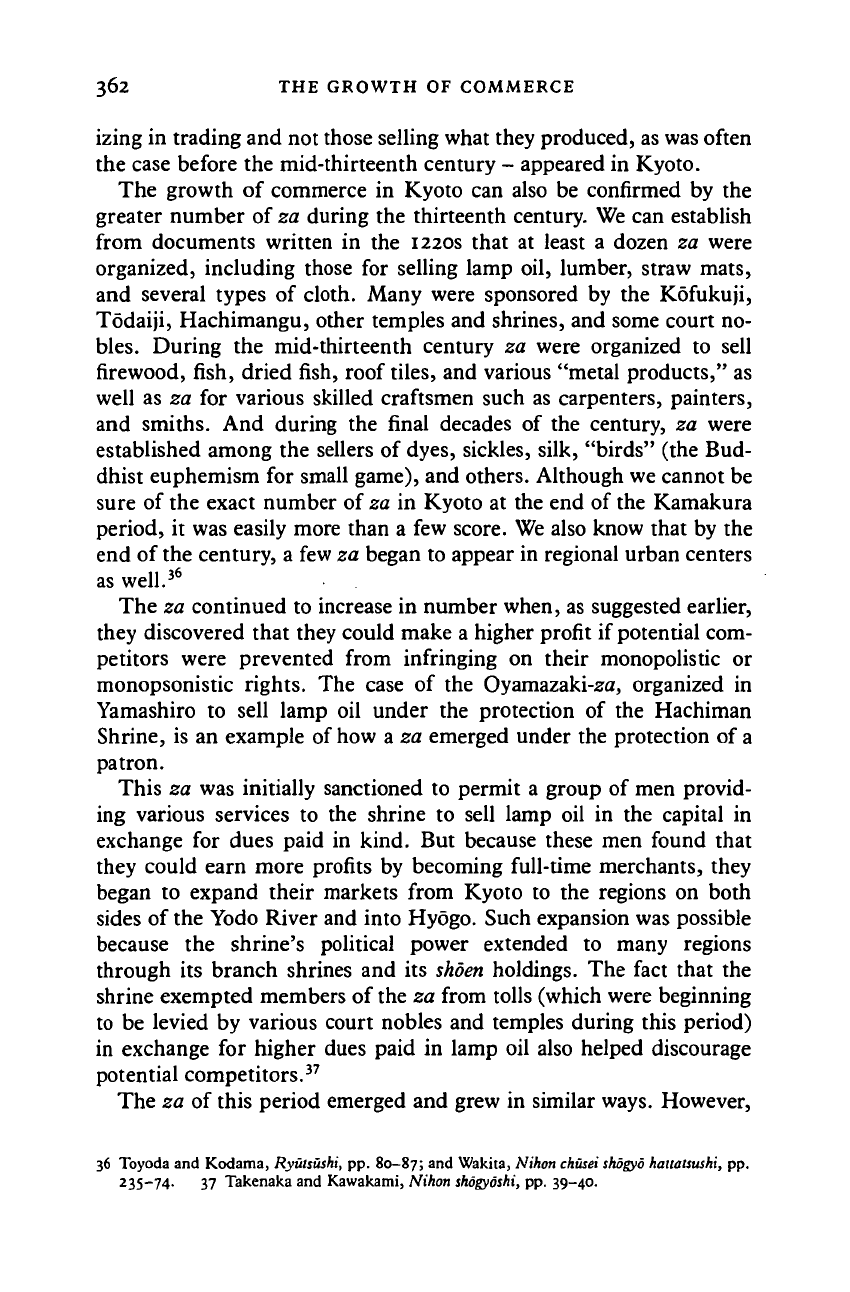
362 THE GROWTH OF COMMERCE
izing in trading and not those selling what they produced, as was often
the case before the mid-thirteenth century - appeared in Kyoto.
The growth of commerce in Kyoto can also be confirmed by the
greater number of za during the thirteenth century. We can establish
from documents written in the 1220s that at least a dozen za were
organized, including those for selling lamp oil, lumber, straw mats,
and several types of cloth. Many were sponsored by the Kofukuji,
Todaiji, Hachimangu, other temples and shrines, and some court no-
bles.
During the mid-thirteenth century za were organized to sell
firewood, fish, dried fish, roof tiles, and various "metal products," as
well as za for various skilled craftsmen such as carpenters, painters,
and smiths. And during the final decades of the century, za were
established among the sellers of dyes, sickles, silk, "birds" (the Bud-
dhist euphemism for small game), and others. Although we cannot be
sure of the exact number of za in Kyoto at the end of the Kamakura
period, it was easily more than a few score. We also know that by the
end of the century, a few za began to appear in regional urban centers
as well.
36
The za continued to increase in number when, as suggested earlier,
they discovered that they could make a higher profit if potential com-
petitors were prevented from infringing on their monopolistic or
monopsonistic rights. The case of the Oyamazaki-za, organized in
Yamashiro to sell lamp oil under the protection of the Hachiman
Shrine, is an example of how a za emerged under the protection of a
patron.
This za was initially sanctioned to permit a group of men provid-
ing various services to the shrine to sell lamp oil in the capital in
exchange for dues paid in kind. But because these men found that
they could earn more profits by becoming full-time merchants, they
began to expand their markets from Kyoto to the regions on both
sides of the Yodo River and into Hyogo. Such expansion was possible
because the shrine's political power extended to many regions
through its branch shrines and its
shoen
holdings. The fact that the
shrine exempted members of the za from tolls (which were beginning
to be levied by various court nobles and temples during this period)
in exchange for higher dues paid in lamp oil also helped discourage
potential competitors.
37
The za of this period emerged and grew in similar ways. However,
36 Toyoda and Kodama, Ryulsushi, pp. 80-87;
ar
>d Wakita, Nihon
chusei shogyd
haitatsushi, pp.
235-74- 37 Takenaka and Kawakami, Nihon
shogyoshi,
pp. 39-40.
Cambridge Histories Online © Cambridge University Press, 2008
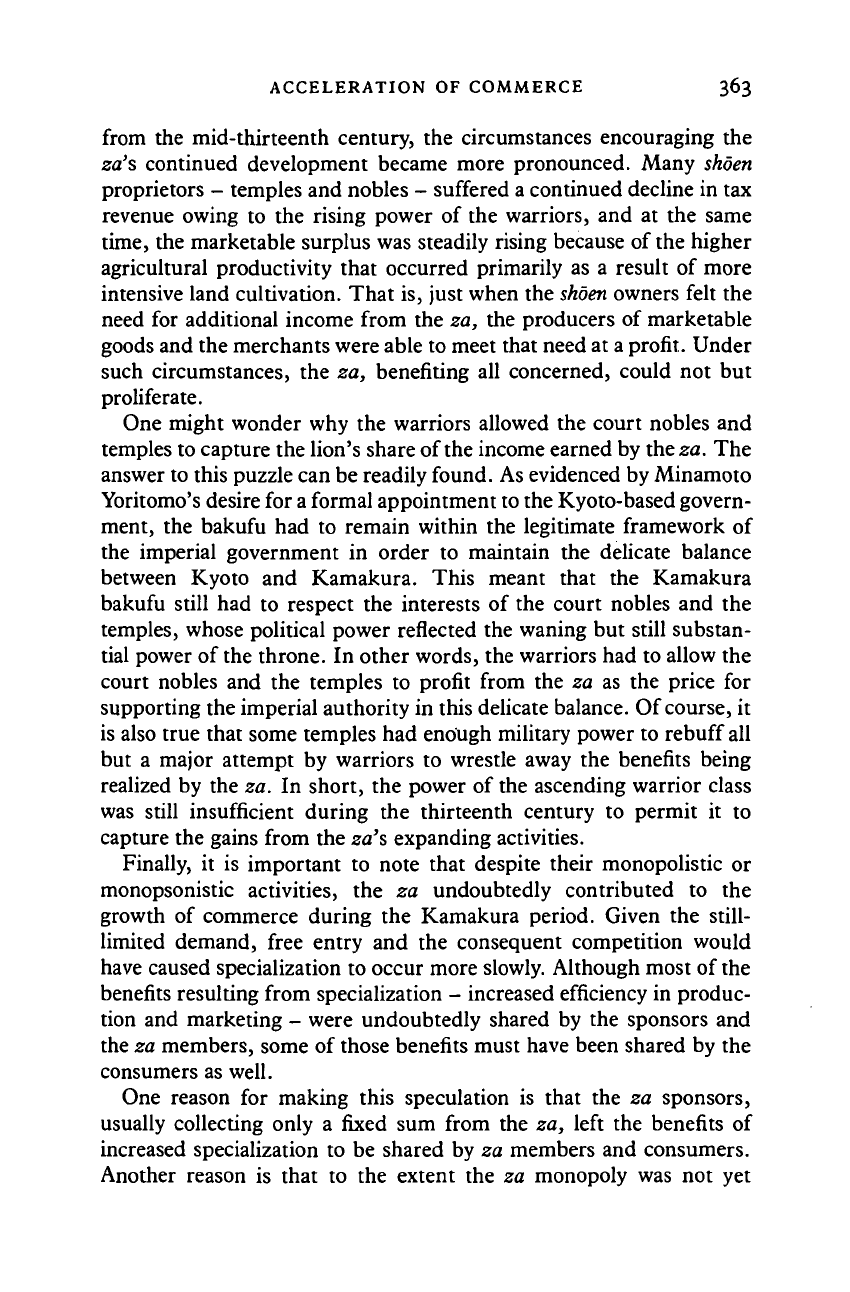
ACCELERATION OF COMMERCE 363
from the mid-thirteenth century, the circumstances encouraging the
za's continued development became more pronounced. Many
skden
proprietors - temples and nobles - suffered a continued decline in tax
revenue owing to the rising power of the warriors, and at the same
time,
the marketable surplus was steadily rising because of the higher
agricultural productivity that occurred primarily as a result of more
intensive land cultivation. That is, just when the
shoen
owners felt the
need for additional income from the za, the producers of marketable
goods and the merchants were able to meet that need at
a
profit. Under
such circumstances, the za, benefiting all concerned, could not but
proliferate.
One might wonder why the warriors allowed the court nobles and
temples to capture the lion's share of the income earned by the za. The
answer to this puzzle can be readily found. As evidenced by Minamoto
Yoritomo's desire for
a
formal appointment to the Kyoto-based govern-
ment, the bakufu had to remain within the legitimate framework of
the imperial government in order to maintain the delicate balance
between Kyoto and Kamakura. This meant that the Kamakura
bakufu still had to respect the interests of the court nobles and the
temples, whose political power reflected the waning but still substan-
tial power of the throne. In other words, the warriors had to allow the
court nobles and the temples to profit from the za as the price for
supporting the imperial authority in this delicate balance. Of course, it
is also true that some temples had enough military power to rebuff all
but a major attempt by warriors to wrestle away the benefits being
realized by the za. In short, the power of the ascending warrior class
was still insufficient during the thirteenth century to permit it to
capture the gains from the za's expanding activities.
Finally, it is important to note that despite their monopolistic or
monopsonistic activities, the za undoubtedly contributed to the
growth of commerce during the Kamakura period. Given the still-
limited demand, free entry and the consequent competition would
have caused specialization to occur more slowly. Although most of the
benefits resulting from specialization - increased efficiency in produc-
tion and marketing - were undoubtedly shared by the sponsors and
the za members, some of those benefits must have been shared by the
consumers as well.
One reason for making this speculation is that the za sponsors,
usually collecting only a fixed sum from the za, left the benefits of
increased specialization to be shared by za members and consumers.
Another reason is that to the extent the za monopoly was not yet
Cambridge Histories Online © Cambridge University Press, 2008
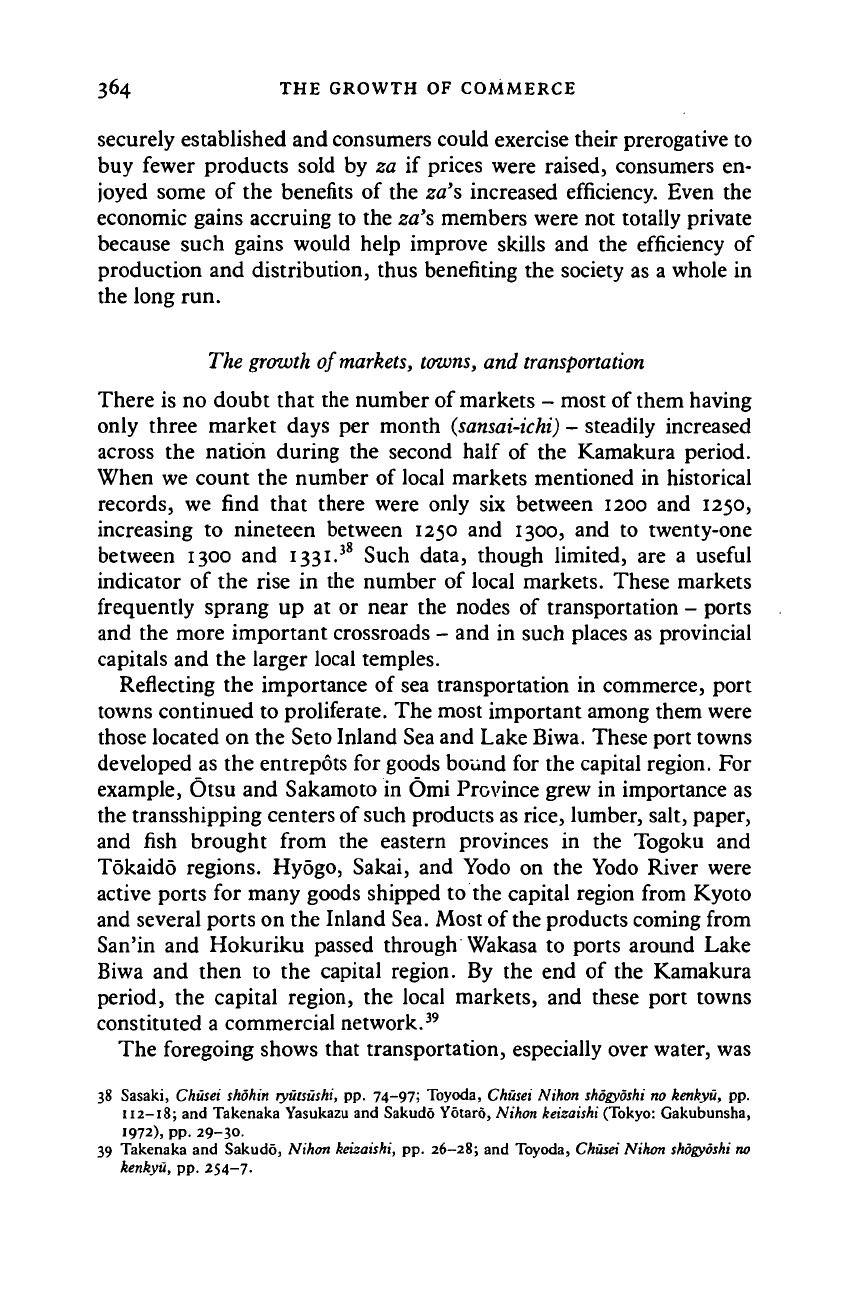
364 THE GROWTH OF COMMERCE
securely established and consumers could exercise their prerogative to
buy fewer products sold by za if prices were raised, consumers en-
joyed some of the benefits of the za's increased efficiency. Even the
economic gains accruing to the za's members were not totally private
because such gains would help improve skills and the efficiency of
production and distribution, thus benefiting the society as a whole in
the long run.
The growth of markets, towns, and
transportation
There is no doubt that the number of markets - most of them having
only three market days per month
(sansai-ichi)
- steadily increased
across the nation during the second half of the Kamakura period.
When we count the number of local markets mentioned in historical
records, we find that there were only six between 1200 and 1250,
increasing to nineteen between 1250 and 1300, and to twenty-one
between 1300 and
1331.
38
Such data, though limited, are a useful
indicator of the rise in the number of local markets. These markets
frequently sprang up at or near the nodes of transportation - ports
and the more important crossroads - and in such places as provincial
capitals and the larger local temples.
Reflecting the importance of sea transportation in commerce, port
towns continued to proliferate. The most important among them were
those located on the Seto Inland Sea and Lake Biwa. These port towns
developed as the entrepots for goods bound for the capital region. For
example, Otsu and Sakamoto in Omi Province grew in importance as
the transshipping centers of such products as rice, lumber, salt, paper,
and fish brought from the eastern provinces in the Togoku and
Tokaido regions. Hyogo, Sakai, and Yodo on the Yodo River were
active ports for many goods shipped to the capital region from Kyoto
and several ports on the Inland Sea. Most of
the
products coming from
San'in and Hokuriku passed through Wakasa to ports around Lake
Biwa and then to the capital region. By the end of the Kamakura
period, the capital region, the local markets, and these port towns
constituted a commercial network.
39
The foregoing shows that transportation, especially over water, was
38 Sasaki, Chusei shohin ryuisushi, pp. 74-97; Toyoda, Chusei Nihon
shogyoshi
no kenkyu, pp.
112-18;
and Takenaka Yasukazu and Sakudo Yotaro, Nihon keizaishi (Tokyo: Gakubunsha,
1972),
pp. 29-30.
39 Takenaka and Sakudo, Nihon keizaishi, pp. 26-28; and Toyoda, Chusei Nihon
shogyoshi
no
kenkyu, pp. 254-7.
Cambridge Histories Online © Cambridge University Press, 2008
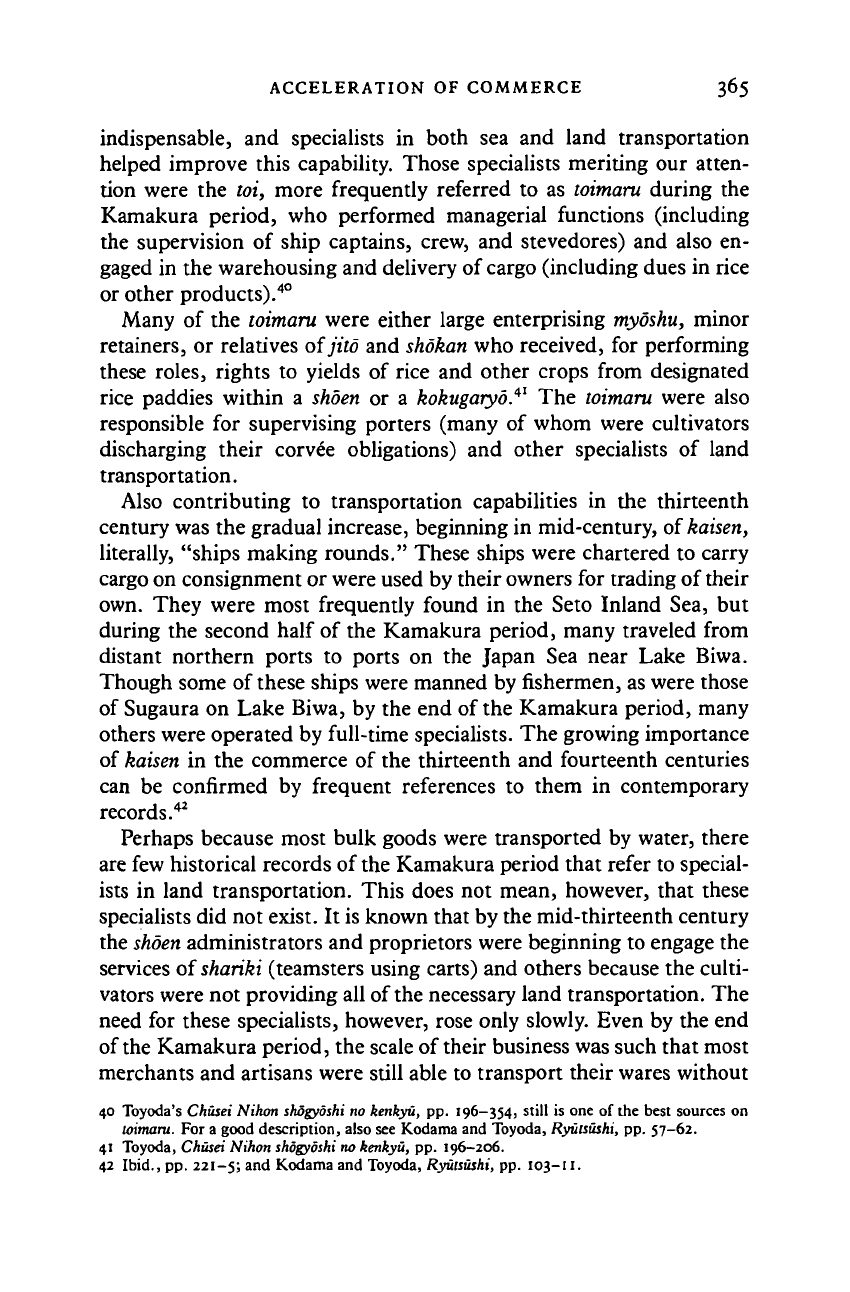
ACCELERATION OF COMMERCE 365
indispensable, and specialists in both sea and land transportation
helped improve this capability. Those specialists meriting our atten-
tion were the toi, more frequently referred to as toimaru during the
Kamakura period, who performed managerial functions (including
the supervision of ship captains, crew, and stevedores) and also en-
gaged in the warehousing and delivery of cargo (including dues in rice
or other products).
40
Many of the toimaru were either large enterprising myoshu, minor
retainers, or relatives oijito and shokan who received, for performing
these roles, rights to yields of rice and other crops from designated
rice paddies within a shden or a kokugaryo.
41
The toimaru were also
responsible for supervising porters (many of whom were cultivators
discharging their corvee obligations) and other specialists of land
transportation.
Also contributing to transportation capabilities in the thirteenth
century was the gradual increase, beginning in mid-century, of kaisen,
literally, "ships making rounds." These ships were chartered to carry
cargo on consignment or were used by their owners for trading of their
own. They were most frequently found in the Seto Inland Sea, but
during the second half of the Kamakura period, many traveled from
distant northern ports to ports on the Japan Sea near Lake Biwa.
Though some of these ships were manned by fishermen, as were those
of Sugaura on Lake Biwa, by the end of the Kamakura period, many
others were operated by full-time specialists. The growing importance
of kaisen in the commerce of the thirteenth and fourteenth centuries
can be confirmed by frequent references to them in contemporary
records.
42
Perhaps because most bulk goods were transported by water, there
are few historical records of the Kamakura period that refer to special-
ists in land transportation. This does not mean, however, that these
specialists did not exist. It is known that by the mid-thirteenth century
the
shoen
administrators and proprietors were beginning to engage the
services of shariki (teamsters using carts) and others because the culti-
vators were not providing all of the necessary land transportation. The
need for these specialists, however, rose only slowly. Even by the end
of the Kamakura period, the scale of their business was such that most
merchants and artisans were still able to transport their wares without
40 Toyoda's Chmei Nihon
shogyoshi
no kenkyu, pp. 196-354, still is one of the best sources on
toimaru. For a good description, also see Kodama and Toyoda, Ryuisushi, pp. 57-62.
41 Toyoda,
Chusei
Nihon
shogyoshi no
kenkyu,
pp. 196—206.
42 Ibid., pp. 221-5; and Kodama and Toyoda, RyuBusAi, pp. 103-11.
Cambridge Histories Online © Cambridge University Press, 2008
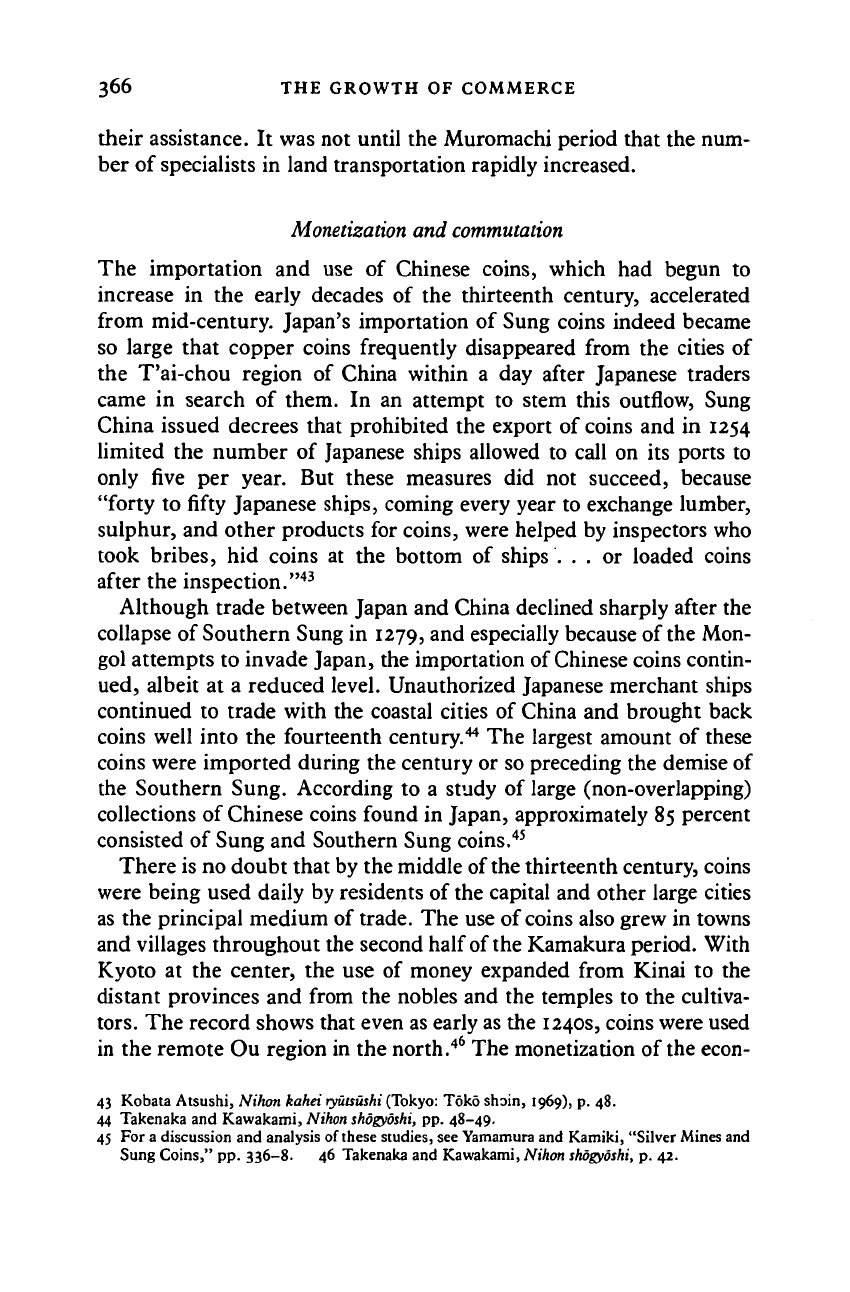
366 THE GROWTH OF COMMERCE
their assistance. It was not until the Muromachi period that the num-
ber of specialists in land transportation rapidly increased.
Monetization and
commutation
The importation and use of Chinese coins, which had begun to
increase in the early decades of the thirteenth century, accelerated
from mid-century. Japan's importation of Sung coins indeed became
so large that copper coins frequently disappeared from the cities of
the T'ai-chou region of China within a day after Japanese traders
came in search of them. In an attempt to stem this outflow, Sung
China issued decrees that prohibited the export of coins and in 1254
limited the number of Japanese ships allowed to call on its ports to
only five per year. But these measures did not succeed, because
"forty to fifty Japanese ships, coming every year to exchange lumber,
sulphur, and other products for coins, were helped by inspectors who
took bribes, hid coins at the bottom of ships ... or loaded coins
after the inspection."
43
Although trade between Japan and China declined sharply after the
collapse of Southern Sung in 1279, and especially because of the Mon-
gol attempts to invade Japan, the importation of Chinese coins contin-
ued, albeit at a reduced level. Unauthorized Japanese merchant ships
continued to trade with the coastal cities of China and brought back
coins well into the fourteenth century.
44
The largest amount of these
coins were imported during the century or so preceding the demise of
the Southern Sung. According to a study of large (non-overlapping)
collections of Chinese coins found in Japan, approximately 85 percent
consisted of Sung and Southern Sung coins.
45
There is no doubt that by the middle of the thirteenth century, coins
were being used daily by residents of the capital and other large cities
as the principal medium of trade. The use of coins also grew in towns
and villages throughout the second half of the Kamakura period. With
Kyoto at the center, the use of money expanded from Kinai to the
distant provinces and from the nobles and the temples to the cultiva-
tors.
The record shows that even as early as the 1240s, coins were used
in the remote Ou region in the north.
46
The monetization of the econ-
43 Kobata Atsushi, Nihon kahei
ryutsushi
(Tokyo: Toko shoin, 1969), p. 48.
44 Takenaka and Kawakami, Nihon
shogyoshi,
pp. 48-49.
45 For a discussion and analysis of these studies, see Yamamura and Kamiki, "Silver Mines and
Sung Coins," pp. 336-8. 46 Takenaka and Kawakami, Nihon
shogyoshi,
p. 42.
Cambridge Histories Online © Cambridge University Press, 2008
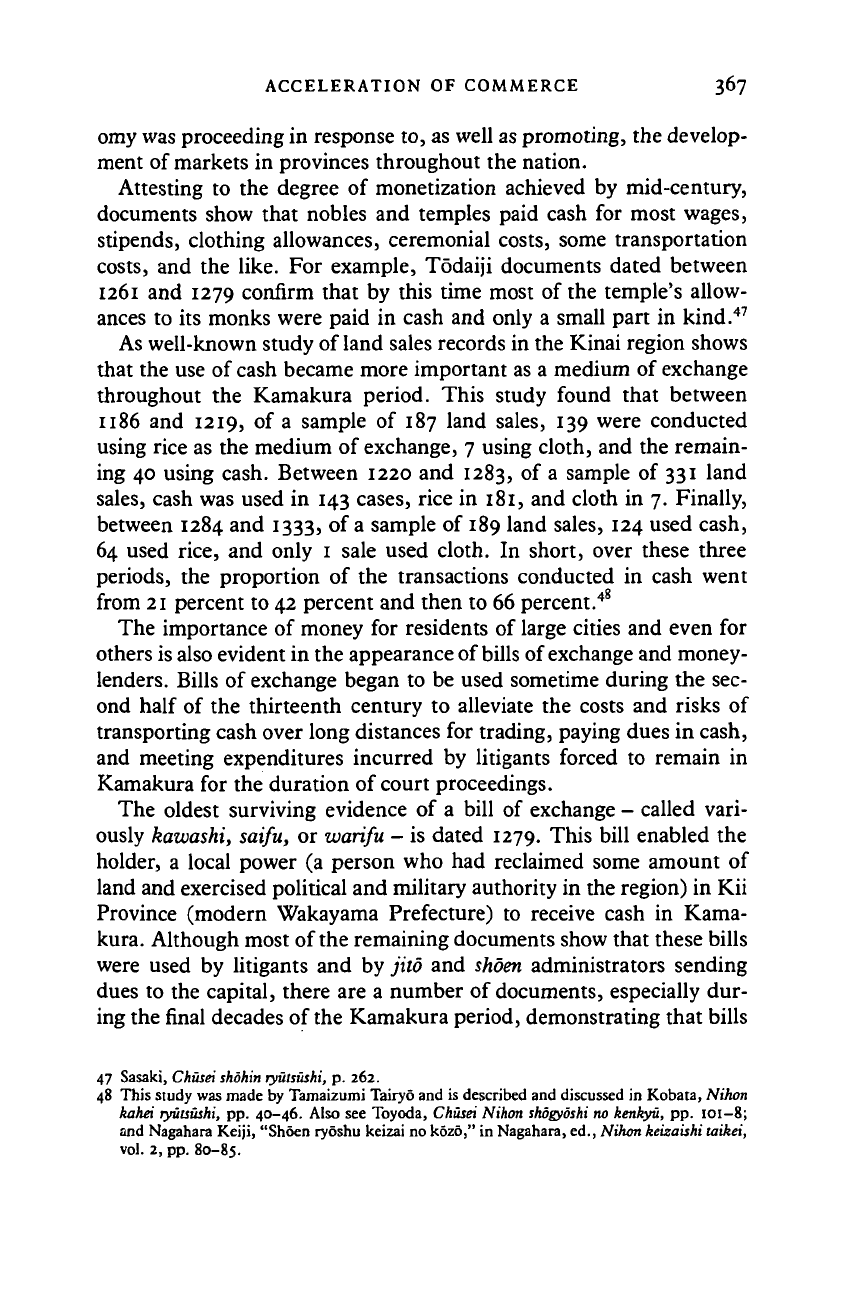
ACCELERATION OF COMMERCE 367
omy was proceeding in response to, as well as promoting, the develop-
ment of markets in provinces throughout the nation.
Attesting to the degree of monetization achieved by mid-century,
documents show that nobles and temples paid cash for most wages,
stipends, clothing allowances, ceremonial costs, some transportation
costs,
and the like. For example, Todaiji documents dated between
1261 and 1279 confirm that by this time most of the temple's allow-
ances to its monks were paid in cash and only a small part in kind.
47
As well-known study of land sales records in the Kinai region shows
that the use of cash became more important as a medium of exchange
throughout the Kamakura period. This study found that between
1186 and 1219, of a sample of 187 land sales, 139 were conducted
using rice as the medium of exchange, 7 using cloth, and the remain-
ing 40 using cash. Between 1220 and 1283, of a sample of 331 land
sales,
cash was used in 143 cases, rice in 181, and cloth in 7. Finally,
between 1284 and 1333, of a sample of 189 land sales, 124 used cash,
64 used rice, and only 1 sale used cloth. In short, over these three
periods, the proportion of the transactions conducted in cash went
from 21 percent to 42 percent and then to 66 percent.
48
The importance of money for residents of large cities and even for
others is also evident in the appearance of bills of exchange and money-
lenders. Bills of exchange began to be used sometime during the sec-
ond half of the thirteenth century to alleviate the costs and risks of
transporting cash over long distances for trading, paying dues in cash,
and meeting expenditures incurred by litigants forced to remain in
Kamakura for the duration of court proceedings.
The oldest surviving evidence of a bill of exchange - called vari-
ously kawashi, saifu, or warifu - is dated 1279. This bill enabled the
holder, a local power (a person who had reclaimed some amount of
land and exercised political and military authority in the region) in Kii
Province (modern Wakayama Prefecture) to receive cash in Kama-
kura. Although most of the remaining documents show that these bills
were used by litigants and by jito and shoen administrators sending
dues to the capital, there are a number of documents, especially dur-
ing the final decades of the Kamakura period, demonstrating that bills
47 Sasaki, Chusei
shohin
ryutsushi, p. 262.
48 This study was made by Tamaizumi Tairyo and is described and discussed in Kobata, Nihon
kahei ryutsushi, pp. 40-46. Also see Toyoda, Chusei Nihon
shogyoshi
no kenkyii, pp. 101-8;
and Nagahara Keiji, "Shoen ryoshu keizai no kozo," in Nagahara, ed., Nihon keizaishi taikei,
vol.
2, pp. 80-85.
Cambridge Histories Online © Cambridge University Press, 2008
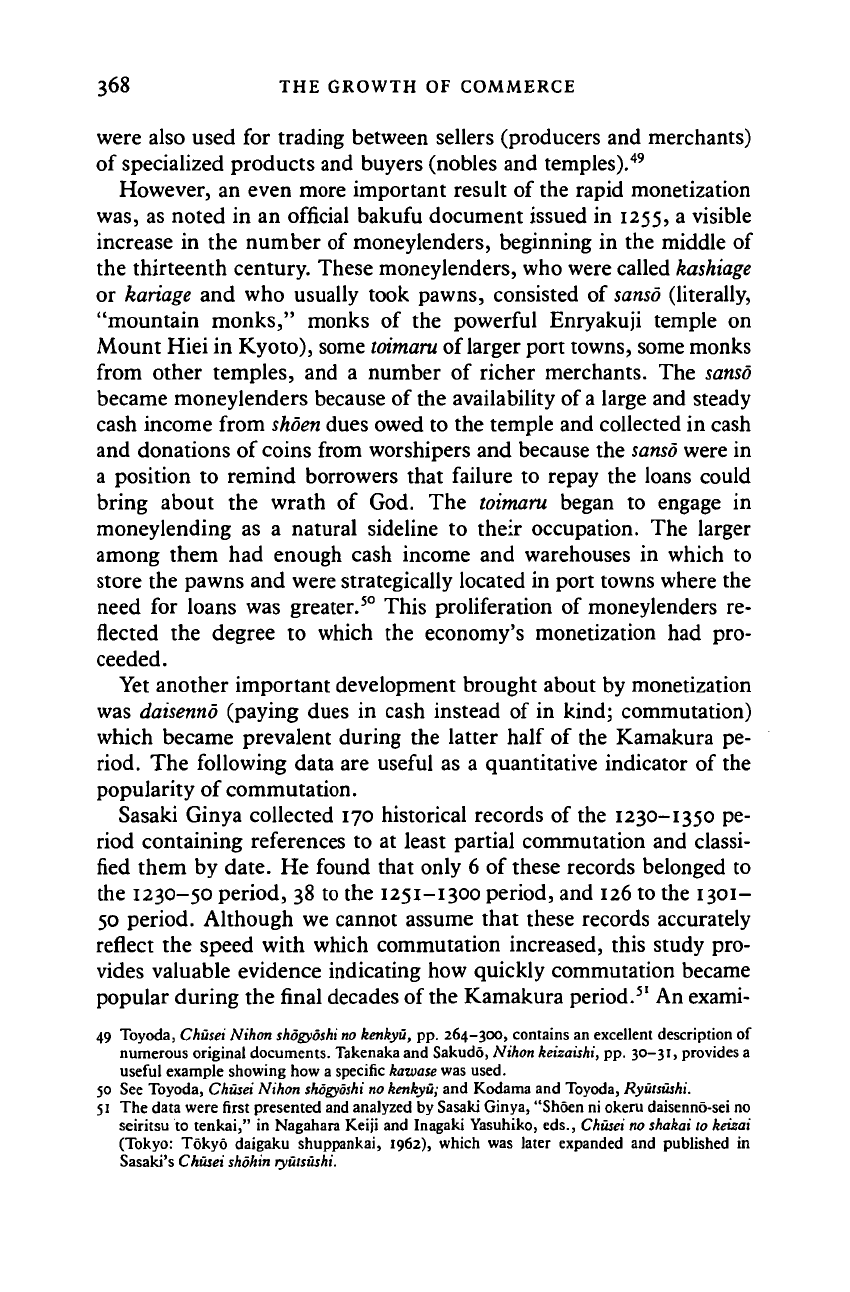
368 THE GROWTH OF COMMERCE
were also used for trading between sellers (producers and merchants)
of specialized products and buyers (nobles and temples).
49
However, an even more important result of the rapid monetization
was,
as noted in an official bakufu document issued in 1255, a visible
increase in the number of moneylenders, beginning in the middle of
the thirteenth century. These moneylenders, who were called
kashiage
or
kariage
and who usually took pawns, consisted of
sanso
(literally,
"mountain monks," monks of the powerful Enryakuji temple on
Mount Hiei in Kyoto), some
toimaru
of larger port towns, some monks
from other temples, and a number of richer merchants. The
sanso
became moneylenders because of the availability of
a
large and steady
cash income from
shoen
dues owed to the temple and collected in cash
and donations of coins from worshipers and because the
sanso
were in
a position to remind borrowers that failure to repay the loans could
bring about the wrath of God. The toimaru began to engage in
money lending as a natural sideline to their occupation. The larger
among them had enough cash income and warehouses in which to
store the pawns and were strategically located in port towns where the
need for loans was greater.
50
This proliferation of moneylenders re-
flected the degree to which the economy's monetization had pro-
ceeded.
Yet another important development brought about by monetization
was
daisenno
(paying dues in cash instead of in kind; commutation)
which became prevalent during the latter half of the Kamakura pe-
riod. The following data are useful as a quantitative indicator of the
popularity of commutation.
Sasaki Ginya collected 170 historical records of the 1230-1350 pe-
riod containing references to at least partial commutation and classi-
fied them by date. He found that only 6 of these records belonged to
the 1230-50 period, 38 to the 1251-1300 period, and 126 to the 1301-
50 period. Although we cannot assume that these records accurately
reflect the speed with which commutation increased, this study pro-
vides valuable evidence indicating how quickly commutation became
popular during the final decades of
the
Kamakura period.
51
An exami-
49 Toyoda, Chusei Nihon
shogyoshi no
kenkyu, pp. 264-30x3, contains an excellent description of
numerous original documents. Takenaka and Sakudo, Nihon keizaishi, pp.
30-31,
provides a
useful example showing how a specific kawase was used.
50 See Toyoda, Chusei Nihon
shogyoshi
no kenkyu; and Kodama and Toyoda, Ryutsushi.
51 The data were first presented and analyzed by Sasaki Ginya, "Shoen ni okeru daisenno-sei no
seiritsu to tenkai," in Nagahara Keiji and Inagaki Yasuhiko, eds., Chusei no shakai
10
keizai
(Tokyo: Tokyo daigaku shuppankai, 1962), which was later expanded and published in
Sasaki's Chusei shohin ryutsushi.
Cambridge Histories Online © Cambridge University Press, 2008
